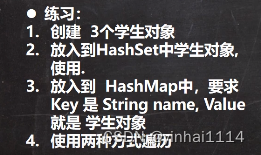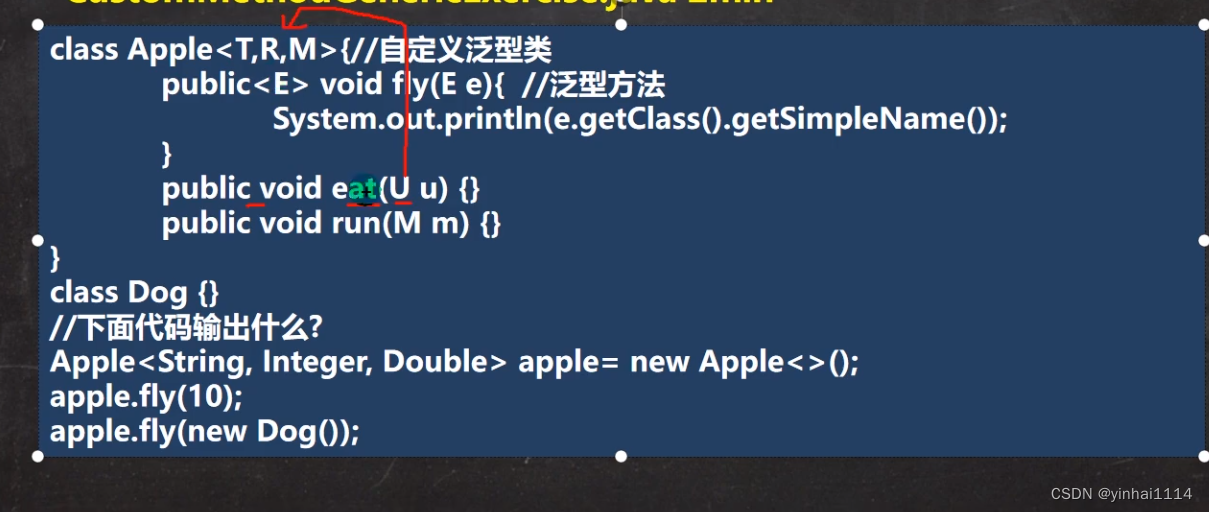项目代码
https://github.com/yinhai1114/Java_Learning_Code/tree/main/IDEA_Chapter15/src/com/yinhai/generic_
https://github.com/yinhai1114/Java_Learning_Code/tree/main/IDEA_Chapter15/src/com/yinhai/customgeneric_
一、泛型的入门和好处
1)请编写程序,在ArrayList 中,添加3个Dog对象
2) Dog对象含有name和age,并输出name和age (要求使用getXxx())
使用传统方法解决,引入泛型
public class Generic01 {public static void main(String[] args) {ArrayList arrayList = new ArrayList();arrayList.add(new Dog("xiaoming",10));arrayList.add(new Dog("xiaohua",5));arrayList.add(new Dog("xiaownag",20));//假如我们的使用过程,不小心加入了一只猫arrayList.add(new Cat("hello" , 15));for (Object o : arrayList) {Dog dog = (Dog)o;System.out.println(dog.getName() + " " +dog.getAge());}}
}
//为了简洁没有加入Dog和Cat类使用传统方法的问题分析
1)不能对加入到集合ArrayList中的数据类型进行约束(不安全)
2)遍历的时候,需要进行类型转换,如果集合中的数据最较大,对效率有影响
泛型的快速入门
public class Generic02 {public static void main(String[] args) {//使用泛型来完成该代码,//1.当我们这样ArrayList<Dog>表示春芳到集合中的元素是Dog类型//2.如果编译器发现添加的类型,不满足要求就会报错ArrayList<Dog1> arrayList = new ArrayList<Dog1>();arrayList.add(new Dog1("xiaoming",10));arrayList.add(new Dog1("xiaohua",5));arrayList.add(new Dog1("xiaownag",20));//假如我们的使用过程,不小心加入了一只猫// arrayList.add(new Cat1("hello" , 15));//3.在遍历的时候可以直接取出Dog类型for (Dog1 dog1 : arrayList) {System.out.println(dog1.getName() + " " +dog1.getAge());}}
}泛型的好处
1) 编译时,检查添加元素的类型,提高了安全性
2) 减少了类型转换的次数,提高效率
不使用泛型
Dog -加入-> Object ->取出-> Dog //放入到ArrayList会先转成Object,在取出时还需要转换成Dog
使用泛型
Dog-> Dog-> Dog //放入时,和取出时,不需要类型转换,提高效率
3) 不再提示编译警告
二、泛型的介绍
inta=10;
泛型=> E = Integer、String、Dog(表示某种数据类型,表示数据类型的数据类型)
1) 泛型又称参数化类型,是Jdk5.0 出现的新特性,解决数据类型的安全性问题
2) 在类声明或实例化时只要指定好需要的具体的类型即可。
3) Java泛型可以保证如果程序在编译时没有发出警告,运行时就不会产生ClassCastException异常。 同时,代码更加简洁、健壮
4) 泛型的作用是:可以在类声明时通过一个标识表示类中某个属性的类型,或者是某个方法的返回值的类型,或者是参数类型。
public class Generic03 {public static void main(String[] args) {Person<String> stringPerson = new Person<String>("Hello");//E表示s的数据类型,该数据类型在定义Person对象的时候指定,即在编译期间,就确定E是什么类型/*class Person{//创建Person对象的时候指定String name;//String表示s的数据类型public Person(String name) {//String可以是参数类型this.name = name;}public String f(){//返回类型使用Stringreturn name;}}*/Person<Integer> integerPerson = new Person<>(1500);//E表示s的数据类型,该数据类型在定义Person对象的时候指定,即在编译期间,就确定E是什么类型/*class Person{//创建Person对象的时候指定Integer name;//Integer表示s的数据类型public Person(Integer name) {//Integer可以是参数类型this.name = name;}public Integer f(){//返回类型使用Integerreturn name;}}*/}
}
class Person<E>{//创建Person对象的时候指定E name;//E表示s的数据类型,该数据类型在定义Person对象的时候指定,即在编译期间,就确定E是什么类型public Person(E name) {//E可以是参数类型this.name = name;}public E f(){//返回类型使用Ereturn name;}
}三、泛型的语法
泛型的声明:
interface接口<T> {}和class类<K,V>{}
//比如: List , ArrayList
说明:
1) 其中T,K,V不代表值,而是表示类型。
2) 任意字母都可以。常用T表示,是Type的缩写
泛型的实例化:
要在类名后面指定类型参数的值(类型)。如:
1) List<String> strList = new ArrayList <String> 0; [举例说明]
2) Iterator<Customer> iterator = customers.iterator();
泛型语法使用

注意,在我们使用的时候如果填入泛型的类型,在调用迭代器时候可以明确指定,直接转型成我们的泛型类型即可。构造器中使用了K V 的关键字的泛型
public class GenericExercise01 {public static void main(String[] args) {Student student1 = new Student("小王");Student student2 = new Student("小马");Student student3 = new Student("小黄");HashSet<Student> hashSet = new HashSet<Student>();hashSet.add(student1);hashSet.add(student2);hashSet.add(student3);HashMap<String, Student> hashMap = new HashMap<String, Student>();hashMap.put(student1.getName(),student1);hashMap.put(student2.getName(),student2);hashMap.put(student3.getName(),student3);System.out.println("=========I遍历获取hashSet=======");for (Student student :hashSet) {System.out.println(student.getName());}Iterator iterator = hashSet.iterator();System.out.println("==========迭代器获取hashSet======");while (iterator.hasNext()) {Student next = (Student)iterator.next();System.out.println(next.getName());}System.out.println("=========I遍历获取hashMap内的entry=======");Set<Map.Entry<String, Student>> entries = hashMap.entrySet();for (Map.Entry entry : entries) {System.out.println(entry.getKey() + " " + entry.getValue());}System.out.println("=========获取key值========");Set<String> strings = hashMap.keySet();for (String key : strings) {System.out.println(key + " " + hashMap.get(key));}System.out.println("========迭代器取出entry========");Set<Map.Entry<String, Student>> entries1 = hashMap.entrySet();Iterator<Map.Entry<String, Student>> iterator1 = entries1.iterator();while (iterator1.hasNext()) {Map.Entry next = iterator1.next();System.out.println(next.getKey() + " " +next.getValue());}}
}
class Student{private String name;public Student(String name) {this.name = name;}public String getName() {return name;}
}四、泛型的注意事项
1. interface List<T>{},public class HashSet<E>{}..等等
说明: T, E只能是引用类型,不能是基本数据类型
看看下面语句是否正确?:
List<Integer> list = new ArrayList <Integer> 0;//ok
List<int> list2 = new ArrayList<int> 0);//报错
2.在给泛型指定具体类型后,可以传入该类型或者其子类类型
3.泛型使用形式
List<Integer> list1 = new ArrayList < Integer> ();
List<Integer> list2 = new ArrayList< > ();
4.如果我们这样写List list3 = new ArrayList();默认给它的泛型是[<E> E就是Object ]
即:
public class GenericDetail {public static void main(String[] args) {//1.给泛型指向数据类型是,要求是引用类型,不能是基本数据类型List<Integer> list = new ArrayList<Integer>(); //OK//List<int> list2 = new ArrayList<int>();//错误//2. 说明//因为 E 指定了 A 类型, 构造器传入了 new A()//在给泛型指定具体类型后,可以传入该类型或者其子类类型Pig<A> aPig = new Pig<A>(new A());aPig.f();Pig<A> aPig2 = new Pig<A>(new B());//A类型的子类型也可以接受aPig2.f();//3. 泛型的使用形式ArrayList<Integer> list1 = new ArrayList<Integer>();List<Integer> list2 = new ArrayList<Integer>();//在实际开发中,我们往往简写//编译器会进行类型推断, 会判断后面的<>是前面<>内的类型,会自动填入ArrayList<Integer> list3 = new ArrayList<>();List<Integer> list4 = new ArrayList<>();ArrayList<Pig> pigs = new ArrayList<>();//4. 如果是这样写 泛型默认是 ObjectArrayList arrayList = new ArrayList();//等价 ArrayList<Object> arrayList = new ArrayList<Object>();/*public boolean add(Object e) {ensureCapacityInternal(size + 1); // Increments modCount!!elementData[size++] = e;return true;}*/Tiger tiger = new Tiger();/*class Tiger {//类Object e;public Tiger() {}public Tiger(Object e) {this.e = e;}}*/}
}
class Tiger<E> {//类E e;public Tiger() {}public Tiger(E e) {this.e = e;}
}class A {}
class B extends A {}class Pig<E> {//E e;public Pig(E e) {this.e = e;}public void f(){System.out.println(e.getClass());}
}五、泛型的课堂练习(经典使用案例)
定义Employee类
1)该类包含: private成员变量name,sal,birthday, 其中birthday为MyDate类的对象;
2)为每一个属性定义getter, setter方法;
3)重写toString方法输出name, sal, birthday
4)MyDate类包含: private成员变量month,day,year;并为每一个属性定义gettesetter方法;
5)创建该类的3个对象,并把这些对象放入ArrayList集合中(ArrayList 需使用泛型来定义),对集合中的元素进行排序,并遍历输出:排序方式:调用ArrayList 的sort方法,传入Comparator对象[使用泛型],先按name排序,如果name相同,则按生日日期的先后排序。如果不太懂多看看ArrayList的排序源码分析
六、自定义泛型类
1.基本语法
class类名<T,R.. >{
成员
}
2.注意细节
1)普通成员可以使用泛型(属性、方法)
2)使用泛型的数组,不能初始化
3)静态方法中不能使用类的泛型
4)泛型类的类型,是在创建对象时确定的(因为创建对象时,需要指定确定类型)
5)如果在创建对象时,没有指定类型,默认为Object
练习

public class CustomGeneric_ {public static void main(String[] args) {//T=Double, R=String, M=IntegerTiger<Double,String,Integer> g = new Tiger<>("john");//<T = double,R = string,M = integer>g.setT(10.9); //OK//g.setT("yy"); //错误,类型不对System.out.println(g);Tiger g2 = new Tiger("john~~");//OK T=Object R=Object M=Objectg2.setT("yy"); //OK ,因为 T=Object "yy"=String 是Object子类System.out.println("g2=" + g2);}
}//1. Tiger 后面泛型,所以我们把 Tiger 就称为自定义泛型类
//2, T, R, M 泛型的标识符, 一般是单个大写字母
//3. 泛型标识符可以有多个.
//4. 普通成员可以使用泛型 (属性、方法)
class Tiger<T, R, M> {String name;R r; //属性使用到泛型M m;T t;//5. 使用泛型的数组,不能初始化//因为数组在new 不能确定T的类型,就无法在内存开空间T[] ts;public Tiger(String name) {this.name = name;}public Tiger(R r, M m, T t) {//构造器使用泛型this.r = r;this.m = m;this.t = t;}public Tiger(String name, R r, M m, T t) {//构造器使用泛型this.name = name;this.r = r;this.m = m;this.t = t;}//6. 静态方法中不能使用类的泛型//因为静态是和类相关的,在类加载时,对象还没有创建//所以,如果静态方法和静态属性使用了泛型,JVM就无法完成初始化// static R r2;// public static void m1(M m) {//// }//方法使用泛型public String getName() {return name;}public void setName(String name) {this.name = name;}public R getR() {return r;}public void setR(R r) {//方法使用到泛型this.r = r;}public M getM() {//返回类型可以使用泛型.return m;}public void setM(M m) {this.m = m;}public T getT() {return t;}public void setT(T t) {this.t = t;}@Overridepublic String toString() {return "Tiger{" +"name='" + name + '\'' +", r=" + r +", m=" + m +", t=" + t +", ts=" + Arrays.toString(ts) +'}';}
}

七、自定义泛型接口
1.基本语法
interface接口名<T,R ....> {
}
2.注意细节
1)接口中,静态成员也不能使用泛型(这个和泛型类规定样)
2)泛型接口的类型,在继承接口或者实现接口时确定
3)没有指定类型,默认为Object
八、自定义泛型方法
1.基本语法
修饰符<T,R > 返回类型 方法名(参数列表) {
2.注意细节
1)泛型方法,可以定义在普通类中,也可以定义在泛型类中
2)当泛型方法被调用时,类型会确定
3)public void eat(E e) {},修饰符后没有<T,R..> eat方法不是泛型方法,而是使用了泛型
3.练习

eat(U u)错误,Dog类内都正确,两个调用都是泛型方法,传入参数才确定泛型指向的类型
public class CustomMethodGenericExercise {public static void main(String[] args) {//T->String, R->Integer, M->DoubleApple<String, Integer, Double> apple = new Apple<>();apple.fly(10);//10 会被自动装箱 Integer10, 输出Integerapple.fly(new Dog());//Dog}
}class Apple<T, R, M> {//自定义泛型类public <E> void fly(E e) { //泛型方法System.out.println(e.getClass().getSimpleName());}//public void eat(U u) {}//错误,因为U没有声明public void run(M m) {} //ok
}class Dog {
}
九、泛型的基础和通配符
1)泛型不具备继承性
List <Object> list = new ArrayList <String>(); //对吗?
2) <?> :支持任意泛型类型
3) <? extends A>:支持A类以及A类的子类,规定了泛型的上限
4) <? super A>:支持A类以及A类的父类,不限于直接父类,规定了泛型的下限
public class GenericExtends {public static void main(String[] args) {Object o = new String("xx");//泛型没有继承性//List<Object> list = new ArrayList<String>();//举例说明下面三个方法的使用List<Object> list1 = new ArrayList<>();List<String> list2 = new ArrayList<>();List<AAA> list3 = new ArrayList<>();List<BBB> list4 = new ArrayList<>();List<CCC> list5 = new ArrayList<>();//如果是 List<?> c ,可以接受任意的泛型类型printCollection1(list1);printCollection1(list2);printCollection1(list3);printCollection1(list4);printCollection1(list5);//List<? extends AA> c: 表示 上限,可以接受 AAA或者AAA子类
// printCollection2(list1);//×
// printCollection2(list2);//×printCollection2(list3);//√printCollection2(list4);//√printCollection2(list5);//√//List<? super AAA> c: 支持AA类以及AA类的父类,不限于直接父类printCollection3(list1);//√//printCollection3(list2);//×printCollection3(list3);//√//printCollection3(list4);//×//printCollection3(list5);//×//冒泡排序//插入排序//....}//说明: List<?> 表示 任意的泛型类型都可以接受public static void printCollection1(List<?> c) {for (Object object : c) { // 通配符,取出时,就是ObjectSystem.out.println(object);}}// ? extends AAA 表示 上限,可以接受 AAA或者AAA子类public static void printCollection2(List<? extends AAA> c) {for (Object object : c) {System.out.println(object);}}// ? super 子类类名AA:支持AAA类以及AAA类的父类,不限于直接父类,//规定了泛型的下限public static void printCollection3(List<? super AAA> c) {for (Object object : c) {System.out.println(object);}}
}class AAA{}class BBB extends AAA {
}class CCC extends BBB {
}、列表(List)、集合(Set)、映射(Map)和元组(Tuple))

















)
